|
Day 1 - Tuesday 10th April
We began our journey from Bush International Airport in Houston, with Ian, Ann, and Robyn coming from Gatwick, UK and Kay and Ray coming from Bermuda. We loaded up our minibus and set off through the hustle and bustle of Houston and heading north to our first destination – Conroe, Texas. We arrived at our hotel in the afternoon, spent a few minutes freshening up, and were off to go birding. We drove the short distance to the W G Jones State Park to explore the pine forest for the rare Red-cockaded Woodpecker. We quickly located a Pine Warbler shortly followed by a stunning pair of Pileated Woodpeckers on the side of a dead tree. We then noticed that the pair actually had a nest hole and the female was seen with her head sticking out. We then spotted a beautiful male Red-headed Woodpecker which allowed us fabulous scope views. A Tufted Titmouse called from the tree tops. Alongside a bushy hedge we saw a White-throated Sparrow and had brief looks at a Yellow-throated Vireo. A Hooded Warbler was heard singing and seen by a few of the group, while nearby a pair of Red-bellied Woodpeckers showed well. A Carolina Wren was seen and several Blue Jays
flew over. Ian found a Hermit Thrush which disappeared just as Steve got on it. Walking back through the forest, we saw more Pine Warblers, a couple of Mourning Doves and several small groups of Cedar Waxwings flying over. It was getting late so we then returned to our hotel after a very quick stop to look at four Pied-billed Grebes on a small pond. We headed back to the hotel pleased with the introduction to our tour - some fine birds and good views of three species of woodpeckers.
Day 2 - Wednesday 11th April
After breakfast we headed back to W. G. Jones State Forest to find two specialties – Red-cockaded Woodpecker and Brown-headed Nuthatch. A Northern Mockingbird greeted us in the parking lot with its repertoire of songs. Next to the path behind the visitor center, we saw a flock of Chipping Sparrows busily feeding on the ground. A nearby oak tree proved quite active with a flock of Cedar Waxwings, an Eastern Bluebird, and a Yellow-rumped Warbler. We walked the main trail into the woodpecker nesting area and were serenaded by several Pine Warblers. A pair of Red-headed Woodpeckers posed on top of a dead snag and the Pileated Woodpecker pair changed places at the nest. We listened and watched with great anticipation for any sign of the Red-cockaded. A Brown-headed Nuthatch flew into one of the pines giving us good views. A pair of Wood Ducks flew by several times allowing us nice flight views of these gorgeous birds. Despite these great sightings, we wondered how long we would have to search for the Red-cockaded Woodpecker. Suddenly we heard the call note as a single bird flew over the trees. Trying to keep a track of it, we followed it to where we thought the bird had settled. We scanned the trees for several minutes with no more sign of the bird. Again we heard the diagnostic call coming from a far tree and Gina quickly spotted a bird on the trunk of a tree. As we got scope views of the bird, another popped into view on the same tree! This pair flew closer to us landing on a tree twenty yards in front of us and was joined by a third bird. Three Red-cockaded Woodpeckers on one tree – in one scope view! Amazing! We marveled at these rare creatures for several minutes as they foraged along the tree trunk sometimes throwing bark chips out.
Happy with our finds, we made our way out of the forest to check another area. As we passed behind the Visitor’s Center, we spotted a Carolina Chickadee working a tall post. Another area with some ponds was quiet so we made our way into the forest getting great looks at a Blue Jay sitting low in a tree. We walked along a trail to an area with Ruby-crowned Kinglet, Northern Cardinal, and a lovely Indigo Bunting. Near another pond, we found a noisy Downy Woodpecker working a tree with a Red-bellied Woodpecker. A Broad-winged Hawk soared above while a Hairy Woodpecker landed in the same tree as the other woodpeckers were a few minutes earlier. We noted our tally of woodpeckers for the morning was six species and were thrilled with our rapidly expanding list.
It was time to move on to the Texas coast, so we picked up some sandwiches and headed south past Houston. Not far off the main highway, we pulled over near some farm fields and found several Buff-breasted Sandpipers, American Golden-Plovers, and one Pectoral Sandpiper. As we sorted out the shorebirds, two Scissor-tailed Flycatchers hawked insects from a power line right above our heads. Several Red-winged Blackbirds were seen as well as a Loggerhead Shrike. As we were about to leave, five more Pectoral Sandpipers flew in and gave excellent views.
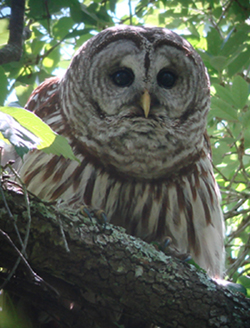 Our next stop was a Cliff Swallow colony under a bridge along the road. Several birds were coming in and out of mud nests often stopping in the entrance hole so we could get good views of their head features. A few Barn Swallows were also around. We moved on to Brazos Bend State Park where we had our picnic lunch next to a lovely lake with views of Roseate Spoonbills in the distance, Black-bellied Whistling Duck, American Coot, Pied-billed Grebe, Great Egret, Snowy Egret, and a small American Alligator. Two young White Ibis foraged on the edge of the lake. After lunch we investigated the area and Steve soon found a pair of Barred Owls, one of which sat in plain view in the branches of a large oak giving us spectacular looks. After watching the owl for several minutes, we realized there were other birds in the forest including a lovely male Northern Parula. Our next stop was a Cliff Swallow colony under a bridge along the road. Several birds were coming in and out of mud nests often stopping in the entrance hole so we could get good views of their head features. A few Barn Swallows were also around. We moved on to Brazos Bend State Park where we had our picnic lunch next to a lovely lake with views of Roseate Spoonbills in the distance, Black-bellied Whistling Duck, American Coot, Pied-billed Grebe, Great Egret, Snowy Egret, and a small American Alligator. Two young White Ibis foraged on the edge of the lake. After lunch we investigated the area and Steve soon found a pair of Barred Owls, one of which sat in plain view in the branches of a large oak giving us spectacular looks. After watching the owl for several minutes, we realized there were other birds in the forest including a lovely male Northern Parula.
We moved on to a larger lake which held more Black-bellied Whistling Ducks, Blue-winged Teal, and a handsome Double-crested Cormorant showing its crests. A few Anhinga flew by as did a Little Blue Heron. In the trees by the shore, we saw another Northern Parula and a nice Eastern Bluebird. We also noticed a large kettle of Broad-winged Hawks with several Black and Turkey Vultures. Gina spotted a Mississippi Kite above the trees beyond the parking lot and we all got flight views through Steve’s scope.
As we left the park, a female Northern Harrier was seen hunting above some farm fields.
Scissor-tailed Flycatchers were common on the power lines and fence posts. As we got out to the main road, Steve spotted another Mississippi Kite and we pulled off to get a better view. A roadside stop at a flooded field held a large group of Short-billed Dowitchers with a few Dunlin mixed in and one American Golden-Plover. We arrived at our hotel in Fulton before dark and enjoyed a few more warblers and a Ruby-throated Hummingbird in the garden before heading out to a restaurant for an excellent seafood dinner.
Day 3 - Thursday 12th April
After breakfast, we went down to the Fulton waterfront for a boat trip on Aransas Bay. We arrived at the dock and enjoyed a gorgeous sunrise over the bay before boarding the MV Skimmer for our morning adventure. As we left the harbor, a group of Bottle-nosed Dolphins appeared very close to the boat. 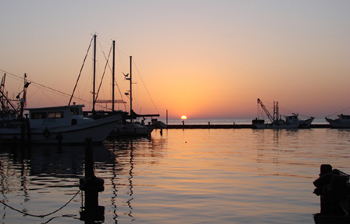 While crossing the bay, we watched a Common Loon, several Double-crested Cormorants diving, and Least and Sandwich Terns fishing in the open water. We reached the first island in the bay and slowed down to make our way through a channel next to a rock jetty. Inside the jetty were sand flats that held several Black Skimmers, Semipalmated Plover, Semipalmated Sandpiper, Sanderlings, and American Avocet. A few Least Sandpipers foraged on the rock jetty while an American Oystercatcher stood on the opposite side of the channel. In the distance, we saw more Bottle-nosed Dolphins porpoising in the water. Just inside the channel, we spotted our first Whooping Cranes in the distance near some White-tailed Deer. There were several sand bars along the channel that held Black-bellied Plovers, Sanderlings, and Forster’s Terns. On the shores of a barrier island, two Marbled Godwits foraged with two Willets. A small group of Black-bellied Whistling Ducks flew over and we spotted Ring-billed Gull on one of the outcrops in the channel. Two Whimbrels flew out over the island and we could see a number of Scissor-tailed Flycatchers perched on the low vegetation. At one point, Captain Tommy steered us toward two Seaside Sparrows perched and singing on stalks of marsh grass giving us good views. The inlets were lined with Snowy Egrets and we spotted a few Mottled Ducks as well. A lovely flock of White-faced Ibis flew by over the marsh with the light showing their facial patterns. An Osprey came quite close to the boat giving good views. However we strained to see three more Whooping Cranes in the distance. Out on the marsh, a Northern Harrier perched up on a stick in the marsh and while another flew over the marsh in the distance. As we turned back, Steve spotted four Whooping Cranes flying which allowed us fantastic views in the morning light. Pleased with decent views of these endangered birds, we moved on to a nesting island for herons and egrets. Roseate Spoonbills were the show stoppers here with their bright pink wings and orange tails. A number of Reddish Egrets were perched in the trees at one end of the island while Great Blue Herons and Snowy Egrets tended their nests on the middle of the island. We enjoyed the rookery show for several minutes commenting on the antics of the birds. Then, Steve spotted a group of five more Whooping Cranes flying by and in the next few minutes several more cranes appeared and we end up with an amazing total of 27 cranes for the day. The return trip to the mainland, yielded several more terns and a female Red-breasted Merganser. Back at the hotel, we checked the garden where two Fox Squirrels were tending their nest. Two Indigo Buntings worked the taller trees as did a bright Orange-crowned Warbler and a few Mourning Doves. While crossing the bay, we watched a Common Loon, several Double-crested Cormorants diving, and Least and Sandwich Terns fishing in the open water. We reached the first island in the bay and slowed down to make our way through a channel next to a rock jetty. Inside the jetty were sand flats that held several Black Skimmers, Semipalmated Plover, Semipalmated Sandpiper, Sanderlings, and American Avocet. A few Least Sandpipers foraged on the rock jetty while an American Oystercatcher stood on the opposite side of the channel. In the distance, we saw more Bottle-nosed Dolphins porpoising in the water. Just inside the channel, we spotted our first Whooping Cranes in the distance near some White-tailed Deer. There were several sand bars along the channel that held Black-bellied Plovers, Sanderlings, and Forster’s Terns. On the shores of a barrier island, two Marbled Godwits foraged with two Willets. A small group of Black-bellied Whistling Ducks flew over and we spotted Ring-billed Gull on one of the outcrops in the channel. Two Whimbrels flew out over the island and we could see a number of Scissor-tailed Flycatchers perched on the low vegetation. At one point, Captain Tommy steered us toward two Seaside Sparrows perched and singing on stalks of marsh grass giving us good views. The inlets were lined with Snowy Egrets and we spotted a few Mottled Ducks as well. A lovely flock of White-faced Ibis flew by over the marsh with the light showing their facial patterns. An Osprey came quite close to the boat giving good views. However we strained to see three more Whooping Cranes in the distance. Out on the marsh, a Northern Harrier perched up on a stick in the marsh and while another flew over the marsh in the distance. As we turned back, Steve spotted four Whooping Cranes flying which allowed us fantastic views in the morning light. Pleased with decent views of these endangered birds, we moved on to a nesting island for herons and egrets. Roseate Spoonbills were the show stoppers here with their bright pink wings and orange tails. A number of Reddish Egrets were perched in the trees at one end of the island while Great Blue Herons and Snowy Egrets tended their nests on the middle of the island. We enjoyed the rookery show for several minutes commenting on the antics of the birds. Then, Steve spotted a group of five more Whooping Cranes flying by and in the next few minutes several more cranes appeared and we end up with an amazing total of 27 cranes for the day. The return trip to the mainland, yielded several more terns and a female Red-breasted Merganser. Back at the hotel, we checked the garden where two Fox Squirrels were tending their nest. Two Indigo Buntings worked the taller trees as did a bright Orange-crowned Warbler and a few Mourning Doves.
We loaded the minibus and went for a drive around the wooded neighborhood in Fulton. Scanning the streets for Black-crested Titmouse, we soon turned up one in a tree at the end of a driveway. The area had a flurry of activity yielding Hooded Warbler, Carolina Wren, White-eyed Vireo, a flock of Cedar Waxwings feeding in a fruit tree, and a Brown-crested Flycatcher. We were invited into a lovely garden where we found a bright Blue-winged Warbler, three Kentucky Warblers, Swainson’s Thrush, Yellow-breasted Chat, and two Black-throated Green Warblers.
 Back out along the street, Gina spotted a Chuck-Wills-Widow perched on the horizontal branch of a tree. After excellent views of this difficult species, Ian alerted us to a nearby waterthrush which turned out to be a Louisiana Waterthrush. A Broad-winged Hawk dashed through the trees and gave us a quick view. Heading south we made a short detour to see Black Skimmers at the town beach. We were able to get incredibly close to hundreds of these magnificent birds and watch them skim in a large rainwater puddle. In the same pool, Short-billed Dowitchers, Least Sandpipers, Semipalmated Sandpipers, Lesser Yellowlegs bathed and we were pleased with excellent views of all of these species. Close by, a female Lesser Scaup, several American Coot, Mallard, Mottled Duck and a very obliging Marbled Godwit showed well. As we left the park, we watched the antics of a Savannah Sparrow noting the field marks for future comparisons with other sparrows. Continuing on to a ferry crossing, we saw a Bronzed Cowbird displaying on the side of the road and more Savannah Sparrows. As we crossed the channel, a couple of Bottle-nosed Dolphins were spotted. Back out along the street, Gina spotted a Chuck-Wills-Widow perched on the horizontal branch of a tree. After excellent views of this difficult species, Ian alerted us to a nearby waterthrush which turned out to be a Louisiana Waterthrush. A Broad-winged Hawk dashed through the trees and gave us a quick view. Heading south we made a short detour to see Black Skimmers at the town beach. We were able to get incredibly close to hundreds of these magnificent birds and watch them skim in a large rainwater puddle. In the same pool, Short-billed Dowitchers, Least Sandpipers, Semipalmated Sandpipers, Lesser Yellowlegs bathed and we were pleased with excellent views of all of these species. Close by, a female Lesser Scaup, several American Coot, Mallard, Mottled Duck and a very obliging Marbled Godwit showed well. As we left the park, we watched the antics of a Savannah Sparrow noting the field marks for future comparisons with other sparrows. Continuing on to a ferry crossing, we saw a Bronzed Cowbird displaying on the side of the road and more Savannah Sparrows. As we crossed the channel, a couple of Bottle-nosed Dolphins were spotted.
Our next site was a small wet forest where we enjoyed incredible close views of many birds, including Warbling Vireo, Yellow-crowned Night-Heron, Green Heron and an almost tame Prothonotary Warbler on the boardwalk. A female Hooded Warbler soon appeared followed by Yellow-throated Warbler, Black-throated Green Warbler, and Northern Parula, Ruby-crowned Kinglet, Summer Tanager, Inca Dove, a female Yellow Warbler, and both Orchard and Baltimore Orioles. As we left this magical spot we found a Northern Waterthrush. This view under the vegetation allowed us to compare the subtle differences between this and the Louisiana we saw earlier. Our last stop of the day was simply unbelievable for close views of just about 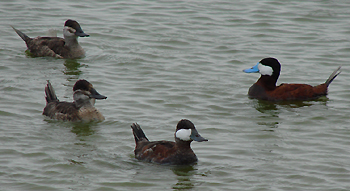 everything. Near the parking lot were Ruby-throated Hummingbirds, a male Hooded Warbler, quite a few Yellow-rumped Warblers, Blue-winged Warbler, and White-eyed Vireo. On the boardwalk we got very close to three Wilson’s Snipe, Stilt Sandpiper, Long-billed Dowitchers, Black-necked Stilt, Least, Western and Semipalmated Sandpipers. Ducks included Green-winged Teal, Northern Pintail, Blue-winged Teal, Northern Shoveler, a group of Ruddy Ducks, and two Cinnamon Teal. A large flock of American Avocets looked superb especially when they all took flight. Several Nutria inhabited the area and as a finale to our excellent day we got close-up looks at a smart-looking Sora. everything. Near the parking lot were Ruby-throated Hummingbirds, a male Hooded Warbler, quite a few Yellow-rumped Warblers, Blue-winged Warbler, and White-eyed Vireo. On the boardwalk we got very close to three Wilson’s Snipe, Stilt Sandpiper, Long-billed Dowitchers, Black-necked Stilt, Least, Western and Semipalmated Sandpipers. Ducks included Green-winged Teal, Northern Pintail, Blue-winged Teal, Northern Shoveler, a group of Ruddy Ducks, and two Cinnamon Teal. A large flock of American Avocets looked superb especially when they all took flight. Several Nutria inhabited the area and as a finale to our excellent day we got close-up looks at a smart-looking Sora.
Day 4 Friday 13th April
After breakfast we set off to a nearby reserve where we saw Piping Plover and Killdeer. In the trees at the edge of the marsh, there were several warblers including Hooded, Yellow-rumped and a nice Louisiana Waterthrush, Yellow-bellied Sapsucker and Downy Woodpecker. Two Peregrine Falcons were spotted flying over the marsh while in the reeds were found Sora and Solitary Sandpiper. Northern Rough-winged Swallows were also present and we heard Marsh Wren which stayed hidden from view. At an overlook area we found Greater and Lesser Yellowlegs together which allowed comparison of their subtle features and a group of White-faced Ibis flew past.
At the Port Aransas jetty, we had close looks at Royal, Sandwich, Forster’s, and four Black Terns mixed in with the ever-present Laughing Gulls. On the beach at the surf line were several
Sanderlings and Black-bellied Plovers. 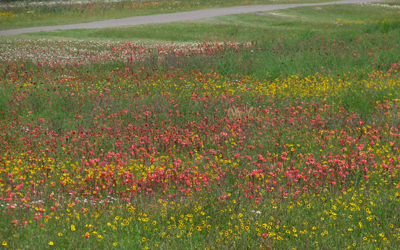 We continued on towards Corpus Christi with some stops along the way for Merlin, Peregrine Falcon, Upland Sandpiper, Long-billed Curlew, Marbled Godwit, Tricolored Herons. One open area held Eastern Meadowlarks, Eastern Kingbirds, Scarlet Tanagers, and Summer Tanagers. We headed into Corpus Christi to a city park for a picnic lunch. This urban gem held Black-and-white Warbler, Blue Grosbeak, Indigo Bunting, Worm-eating Warbler, Blue-winged, Hooded, and Kentucky Warbler, Common Yellowthroat, and a difficult Yellow-breasted Chat. We also saw White-winged Dove, Ruby-throated Hummingbird, and two Great-crested
Flycatchers. We left the city and drove to the small town of Sarita where a male Hooded Oriole was found in a tree in the center of town. We cruised the street admiring the fields of lovely wildflowers while watching Brewer’s Blackbird and Couch’s Kingbirds on the ground on power lines. At the roadside stop, more Brewer’s Blackbirds were found along side the parking area. By now, we were able to get a handle on the differences between all of the grackles and blackbirds we were seeing. We continued toward South Padre Island crossing open areas where several Swainson’s Hawks were perched on pylons. From the road, a distant White-tailed Hawk was spotted and at one point Gina stopped to show us a White-tailed Kite perched on a power line. We continued on towards Corpus Christi with some stops along the way for Merlin, Peregrine Falcon, Upland Sandpiper, Long-billed Curlew, Marbled Godwit, Tricolored Herons. One open area held Eastern Meadowlarks, Eastern Kingbirds, Scarlet Tanagers, and Summer Tanagers. We headed into Corpus Christi to a city park for a picnic lunch. This urban gem held Black-and-white Warbler, Blue Grosbeak, Indigo Bunting, Worm-eating Warbler, Blue-winged, Hooded, and Kentucky Warbler, Common Yellowthroat, and a difficult Yellow-breasted Chat. We also saw White-winged Dove, Ruby-throated Hummingbird, and two Great-crested
Flycatchers. We left the city and drove to the small town of Sarita where a male Hooded Oriole was found in a tree in the center of town. We cruised the street admiring the fields of lovely wildflowers while watching Brewer’s Blackbird and Couch’s Kingbirds on the ground on power lines. At the roadside stop, more Brewer’s Blackbirds were found along side the parking area. By now, we were able to get a handle on the differences between all of the grackles and blackbirds we were seeing. We continued toward South Padre Island crossing open areas where several Swainson’s Hawks were perched on pylons. From the road, a distant White-tailed Hawk was spotted and at one point Gina stopped to show us a White-tailed Kite perched on a power line.
Day 5 Saturday 14th April
As we headed out in the morning toward South Padre Island, it was obvious that it was going to be a wild and windy day, not the best for finding migrants. At our first stop, we walked out onto a boardwalk overlooking a marsh. The northerly wind was so strong that it bent the reeds over. We held on to our hats and struggled to see what was in the marsh. Some of us got a quick glimpse of a Least Bittern as it disappeared into the grasses. It was quiet and initially very disappointing so we made our way back to a tiny block of bushes and small trees with some fruit and nectar feeders. Amazingly, this area held a variety of birds that, like us were seeking shelter. A Hooded Warbler hopped around on the edge of the thicket - our first sign that this spot was going to be interesting. It was sheltered from the wind by a large building and several species were concentrated here including Summer Tanagers Indigo Buntings, Prothonotary Warbler, and 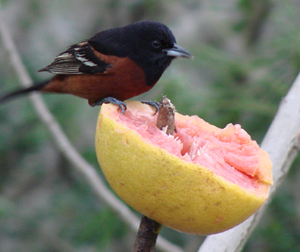 several Lincoln’s Sparrows. On one end, a Yellow-billed Cuckoo gave close views as did several Orchard Orioles, a few Ruby-crowned Kinglets showing their ruby crowns, Scissor-tailed Flycatchers, Lark Sparrows, a nice Tennessee Warbler, lots of cowbirds and blackbirds. One particular tree in a garden area had several birds including Couch’s Kingbird, Yellow-breasted Chat, Nashville Warbler, and some Western Kingbirds. several Lincoln’s Sparrows. On one end, a Yellow-billed Cuckoo gave close views as did several Orchard Orioles, a few Ruby-crowned Kinglets showing their ruby crowns, Scissor-tailed Flycatchers, Lark Sparrows, a nice Tennessee Warbler, lots of cowbirds and blackbirds. One particular tree in a garden area had several birds including Couch’s Kingbird, Yellow-breasted Chat, Nashville Warbler, and some Western Kingbirds.
We dragged ourselves away from this area for a late breakfast and then moved on to two small sanctuaries amid the urban development of South Padre. As we got out of the van, Gina spotted two Dickcissels. We walked a short way toward the viewing area and were stopped in our tracks by a gorgeous male Painted Bunting which glowed in the late morning light. This brilliant bird blew us away and got a “Yabba-dabba-doo!” from Robbie. The shrubs of this tiny reserve were loaded with birds including Nashville, Tennessee, Black-throated Green, and Blue-winged warblers, several Catbirds, a few Chipping and Clay-colored Sparrows. Once again a Yellow-breasted Chat gave quick glimpses. We were very pleased to find this spot and realized how important these small green areas were for migrants.
From here we drove toward Laguna Atascosa stopping along the way for an Aplomado Falcon on its nest. Its mate was soon located on a small tree and as we watched a Cooper’s Hawk came past and was duly seen off by the falcon. A White-tailed Hawk soared in the distance but did not come close to the Falcon’s territory.As we neared Laguna, several Killdeer were seen along the roadway. At the feeders, we got our first looks at the lovely Green Jay and Plain Chachalaca. Kay caught a glimpse of a Long-billed Thrasher in the brush at the back. Along one of the forest trails, we found a gray phase Eastern Screech-Owl and were able to get good scope looks through the trees.
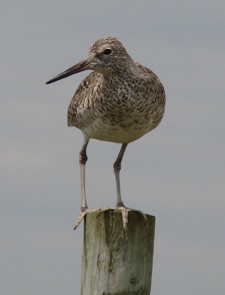 We took the wildlife drive stopping at several places for Mottled Duck, Gadwall, White-faced Ibis, White Ibis, American Alligator, Northern Shoveler, Fulvous Whistling Duck, American Coot, and many Willets. Further on, our first Greater Roadrunner crossed the road much to Robbie’s delight. As we rounded the corner toward the bay, a Golden-fronted Woodpecker was heard calling and briefly showed. Several Osprey were seen – some hovering over the water and one eating a fish on a sandy beach. We continued on the loop road until we saw another Roadrunner to which Robyn again exclaimed, “Yabba-dabba-doo!”. Several Horned Larks were spotted along the road. We stopped at the Verdin corner to try to get a look. After a few minutes, a gorgeous male perched at eye level on a bush not three yards away giving us excellent views. We took the wildlife drive stopping at several places for Mottled Duck, Gadwall, White-faced Ibis, White Ibis, American Alligator, Northern Shoveler, Fulvous Whistling Duck, American Coot, and many Willets. Further on, our first Greater Roadrunner crossed the road much to Robbie’s delight. As we rounded the corner toward the bay, a Golden-fronted Woodpecker was heard calling and briefly showed. Several Osprey were seen – some hovering over the water and one eating a fish on a sandy beach. We continued on the loop road until we saw another Roadrunner to which Robyn again exclaimed, “Yabba-dabba-doo!”. Several Horned Larks were spotted along the road. We stopped at the Verdin corner to try to get a look. After a few minutes, a gorgeous male perched at eye level on a bush not three yards away giving us excellent views.
We left the loop trail and headed back toward South Padre. Ann wanted a photo of the beautiful opuntia cactus in bloom so we stopped along the road. Just as she was photographing the immense plant, three Long-billed Thrashers flew above the cactus and landed in a tree just behind. Fantastic! Further on, we stopped along the road to check some small birds. A lovely Dickcissel flew into the grasses and eventually came to the fence wire showing very well.
We continued on to South Padre where a Harley Davidson convention was in full swing at the Convention 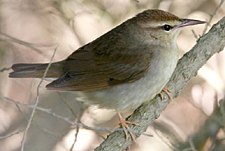 Center with hundreds of revving motorcycles. We approached the birding area wondering what we would find and, to our delight, there were several warblers and orioles actively feeding in the vegetation. Once again, we got close looks at Yellow-throated and Prothonotary Warbler, Northern Parula, and Ruby-throated Hummingbird. New species included Blue-headed Vireo and Northern Waterthrush. A Swainson’s Warbler was reported in the thick brush so we searched for awhile eventually getting cracking looks at this skulking little bird. What a way to end a great birding day! We left the convention center wondering if the bikers had any idea what was going on in the natural area behind. On the way out of South Padre, we found a lovely
restaurant for dinner. Center with hundreds of revving motorcycles. We approached the birding area wondering what we would find and, to our delight, there were several warblers and orioles actively feeding in the vegetation. Once again, we got close looks at Yellow-throated and Prothonotary Warbler, Northern Parula, and Ruby-throated Hummingbird. New species included Blue-headed Vireo and Northern Waterthrush. A Swainson’s Warbler was reported in the thick brush so we searched for awhile eventually getting cracking looks at this skulking little bird. What a way to end a great birding day! We left the convention center wondering if the bikers had any idea what was going on in the natural area behind. On the way out of South Padre, we found a lovely
restaurant for dinner.
Day 7 Sunday 15th April
This morning we set off early to get to a known spot for Botteri’s Sparrow. As we drove the track toward this site it became more and more rutted until eventually we came to a halt behind a car that had been abandoned in an area of thick mud. It was impassable and so we tried for this elusive bird from here but to no avail. We heard and saw several Sedge Wrens, as well as Savannah Sparrows, Upland Sandpiper, Least Sandpiper, and Whimbrel. As we drove back out, we got great looks at an immature White-tailed Hawk. We found out that the other side of this track was also impassable and had to concede that we could not get to this bird this year. Moving on toward Brownsville, we made an unexpected stop to watch a Harris’s Hawk preening on a telephone wire. Ian spotted some friends we had met yesterday who were stopped along the road. We joined them and we were soon watching four Tamaulipas Crows. Two were building a nest in a tall palm and we studied their features as they moved from trees to power poles gathering nesting material. Just down the road, we made a quick stop for four elegant Swallow-tailed Kites which gave fabulous views, which prompted a few more choice words from Robbie. We arrived at the Sabal Palm Audubon Sanctuary and checked in at the 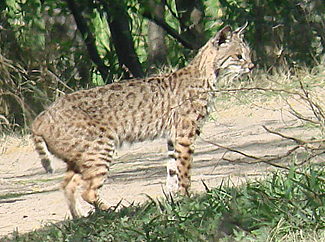 Visitor’s Center. We were soon treated to our first views of Buff-bellied Hummingbird and White-tipped Doves. In the forest, we got good looks at Olive Sparrows and several of Golden-fronted Woodpeckers. A Rose-breasted Grosbeak showed briefly as we made our way to a pond where we enjoyed Least and Pied-billed Grebes, Prothonotary Warbler, and a nice Ladder-backed Woodpecker. We
then drove to Santa Ana Wildlife Refuge. Not far into the park we enjoyed Altamira Oriole, Brown-crested Flycatcher, and Couch’s Kingbird. Next up was a fabulous Northern Beardless Tyrannulet. We climbed a tower lookout and saw several kingbirds but very little else in the heat of the day. On another trail we came across a stunning bobcat which did not run off and allowed us unbelievable views before slowly walking away. On the ponds were Black-bellied Whistling Ducks, American Wigeon, White-faced Ibis, Black-necked Stilt, Gadwall, and a scope view of a Green Kingfisher. Overhead, a Harris’s Hawk soared by. We continued on the River Trail which was quiet and afforded
obscured views of the Rio Grande which forms the border between Texas and Mexico. Visitor’s Center. We were soon treated to our first views of Buff-bellied Hummingbird and White-tipped Doves. In the forest, we got good looks at Olive Sparrows and several of Golden-fronted Woodpeckers. A Rose-breasted Grosbeak showed briefly as we made our way to a pond where we enjoyed Least and Pied-billed Grebes, Prothonotary Warbler, and a nice Ladder-backed Woodpecker. We
then drove to Santa Ana Wildlife Refuge. Not far into the park we enjoyed Altamira Oriole, Brown-crested Flycatcher, and Couch’s Kingbird. Next up was a fabulous Northern Beardless Tyrannulet. We climbed a tower lookout and saw several kingbirds but very little else in the heat of the day. On another trail we came across a stunning bobcat which did not run off and allowed us unbelievable views before slowly walking away. On the ponds were Black-bellied Whistling Ducks, American Wigeon, White-faced Ibis, Black-necked Stilt, Gadwall, and a scope view of a Green Kingfisher. Overhead, a Harris’s Hawk soared by. We continued on the River Trail which was quiet and afforded
obscured views of the Rio Grande which forms the border between Texas and Mexico.
Day 8 Monday 16th April
After breakfast we drove to Bentsen State Park the World Birding Center which did not open until
8 AM! As we waited for the tram to take us to the Raptor Observation Tower a Buff-bellied Hummingbird came to feed on some flowers on a trellis. At the tower, raptors included Broad-winged Hawks, a Cooper’s Hawk, some distant unidentified kites, a White-tailed Kite, a Sharp-shinned Hawk, and an Osprey. On our way out, more Broad-wingeds and Swainson’s Hawks passed overhead. Heading back toward the center, we checked the feeding stations which held lots of Indigo Buntings, White-winged, Inca, and Common Ground Dove. A Green Jay flew in and two Plain Chachalacas foraged under the feeders. Back at the Visitor’s Center, we looked at the shop and had a drink and then headed out to Anzandulas Park. Here we enjoyed our picnic lunch but our walk around was hampered by the strong wind. Despite the wind, we found a Black Phoebe, Black-throated Green Warbler, and Black-crested Titmouse as well as several Golden-fronted Woodpeckers and a few Ladder-backed Woodpeckers. As we were leaving we stopped to view a kettle of four or five hundred Broad-winged Hawks – an amazing spectacle.
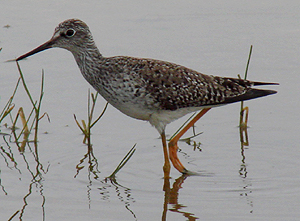 Back in McAllen, we drove to the obligatory sewage ponds where we saw several Least Sandpipers, a few Semipalmateds, a Pectoral Sandpiper, a few Baird’s Sandpipers, Lesser Yellowlegs, two Gull-billed Terns. The odor was everything one might imagine but the birds were fabulous so we held our breaths! We headed back to our hotel for a siesta and then an early dinner so that we could get back to Bentsen around dusk. As we pulled in to the park we jumped out of the bus as there were about 10 Mississippi Kites drifting low overhead. As we watched these birds, more appeared and we counted nearly 100 including kites - many very low allowing excellent views. We walked into the park and soon located a singing Clay-colored Robin showing exceptionally well in a dead tree. Further on, we heard a Ferruginous Pygmy-Owl which after a game of call and seek, we eventually tracked it down to three feet off the ground in a tiny bush. Once again we enjoyed superb views of another great bird. Back in McAllen, we drove to the obligatory sewage ponds where we saw several Least Sandpipers, a few Semipalmateds, a Pectoral Sandpiper, a few Baird’s Sandpipers, Lesser Yellowlegs, two Gull-billed Terns. The odor was everything one might imagine but the birds were fabulous so we held our breaths! We headed back to our hotel for a siesta and then an early dinner so that we could get back to Bentsen around dusk. As we pulled in to the park we jumped out of the bus as there were about 10 Mississippi Kites drifting low overhead. As we watched these birds, more appeared and we counted nearly 100 including kites - many very low allowing excellent views. We walked into the park and soon located a singing Clay-colored Robin showing exceptionally well in a dead tree. Further on, we heard a Ferruginous Pygmy-Owl which after a game of call and seek, we eventually tracked it down to three feet off the ground in a tiny bush. Once again we enjoyed superb views of another great bird.
Down by the river we scoped a few Neotropic Cormorants before the first of 18 Lesser Nighthawks came out and hawked over the river and tree tops. It was now almost dusk so we headed toward the forest where there were several Collared Peccaries with tiny piglets. Inside the forest, we got superb views of an Eastern Screech Owl, and nearby we heard a close Elf Owl which would not show before it fell silent. Out on the road a Common Pauraque gave unbelievable close views perched on the ground and flying around our heads. Coyotes howled nearby and the starlight sky sparkled. Along the road back to the car park we heard more Elf Owls and a Eastern Screech Owl. With the stars out and fire flies lighting up the trees we ended a superb evening.
Day 9 Tuesday 17th April
Today we had a very early breakfast so we could arrive at Chapeno for first light. We were invited into the yard by Martha who was filling the feeders. She told us about the typical routine of the Brown Jay and after some time, a single jay flew in and fed on an orange before disappearing. Most of the group got on to it although it was quite brief. Walking down toward the Rio Grande, we saw Osprey perched in a tree, then a Green Kingfisher, and a superb Ringed Kingfisher which flew past giving us wonderful view before pulling up into a tree overhanging the river where we could scope it. A pair of Audubon’s Orioles were then spotted on a tree top, while a closer pair of Altamira Orioles gave nice views. Back at the house, we went onto the observation tower and saw Purple Martins, Bank Swallows, and scope views of several Red-billed Pigeons,
plus Harris Hawk and Red-shouldered Hawk. Moving on to our next spot we made a quick stop for two  immaculate Yellow-headed Blackbirds. Down by the river, we spotted Double-crested Cormorants, Plain Chachalacas, and a couple of Mottled Ducks. Leaving here we stopped for our first Ash-throated Flycatcher. We drove along to our next site and almost collided with a kamikaze Roadrunner. A lovely Curve-billed Thrasher posed for us while we recovered from the trauma of the near miss with the Roadrunner. We walked the campground finding more thrashers and a nice Orange-crowned Warbler, Bewick’s Wrens were very vocal and showy. We also saw Black-throated Sparrows and several Pyrrhuloxias in the scrub as well as an accommodating Verdin on a wire. Bell’s Vireo sang but stayed well hidden. A White-crowned Sparrow showed well and as we were about to leave, a Peregrine Falcon flew by. immaculate Yellow-headed Blackbirds. Down by the river, we spotted Double-crested Cormorants, Plain Chachalacas, and a couple of Mottled Ducks. Leaving here we stopped for our first Ash-throated Flycatcher. We drove along to our next site and almost collided with a kamikaze Roadrunner. A lovely Curve-billed Thrasher posed for us while we recovered from the trauma of the near miss with the Roadrunner. We walked the campground finding more thrashers and a nice Orange-crowned Warbler, Bewick’s Wrens were very vocal and showy. We also saw Black-throated Sparrows and several Pyrrhuloxias in the scrub as well as an accommodating Verdin on a wire. Bell’s Vireo sang but stayed well hidden. A White-crowned Sparrow showed well and as we were about to leave, a Peregrine Falcon flew by.
We moved on to San Ygnacio where a nice little reserve along the river held several butterflies. We searched the river’s edge and eventually found a male White-collared Seedeater. In a nearby city park, we found several Cedar Waxwings and a Yellow-rumped Warbler as well as a few Chihuahuan Ravens.
Day 10 Wednesday 18th April
As we loaded the vans in the morning, we heard a Cactus Wren calling and found it in a palm tree next to the hotel grounds. Our morning drive to Concan was enlivened by roadside birds such as Swainson’s and Harris’ hawks, American Kestrel, countless Scissor-tailed Flycatchers, and a few Ash-throated flycatchers. We arrived at Neal’s Lodge and settled into the best cabins overlooking the turquoise flowing river. It was a lovely setting for a picnic lunch and we had a short break during the heat of the day.
It wasn't long though, before we met for some birding in and around the grounds. Robbie was soon yaba daba doing again in admiration of his first-ever Vermillion Flycatcher and we all joined in his excitement over this gorgeous creature. At one of the feeders we saw several Lesser Goldfinches, House Finches, Clay-colored Sparrows, Field Sparrow, Black-throated Sparrow, Lincoln’s Sparrow, Cardinals, and Black-chinned Hummingbirds. A close Bell’s Vireo sang but remained elusive to see. We moved on to a trail in the forest. Chipping Sparrows were present here as was Nashville and Orange-crowned Warbler, but a real highlight was when Gina found a singing Golden-cheeked Warbler right above our heads. We had wonderful views of this highly sought after, localized and rare breeding bird. On our way out, we checked another set of feeders and
saw more Lesser Goldfinches, Olive Sparrows, Hooded Orioles, two Long-billed Thrashers, and an Orange-crowned Warbler. We tore ourselves away to go for an early dinner so that we could visit the bat caves in the evening. We arrived at the meeting spot for the bats where several other people were waiting. No guide arrived to unlock the gate so after a phone call or two to find out what was happening we all decided we should go on in and see the bats for ourselves. After a long walk, we arrived at the cave. It 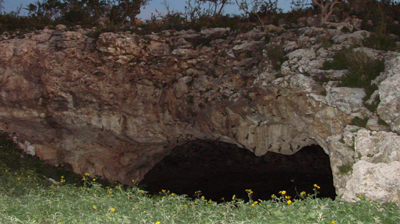 was quiet except for a group of Cave Swallows flying around. A Rock Wren called from the other side of the seating area. As the sun began to set, the first bats started to emerge from the cave flying diagonally past us. Shortly after the bats started, a Merlin flew in and took one of the unsuspecting creatures. For more than 30 minutes, Mexican Free-tailed Bats streamed out of the cave against the sunset giving an unforgettable and exciting show. We walked back in the dark under starlit skies and next to fields sparkling with fire flies. A Chuck-wills-widow and a Whippoorwill serenaded us as we made our way back to the vehicles. This evening was indeed magical and the perfect end to another great day. was quiet except for a group of Cave Swallows flying around. A Rock Wren called from the other side of the seating area. As the sun began to set, the first bats started to emerge from the cave flying diagonally past us. Shortly after the bats started, a Merlin flew in and took one of the unsuspecting creatures. For more than 30 minutes, Mexican Free-tailed Bats streamed out of the cave against the sunset giving an unforgettable and exciting show. We walked back in the dark under starlit skies and next to fields sparkling with fire flies. A Chuck-wills-widow and a Whippoorwill serenaded us as we made our way back to the vehicles. This evening was indeed magical and the perfect end to another great day.
Day 11 Thursday 19th April
After a great breakfast, we spent a few minutes in the car park looking at Golden-fronted Woodpecker, Purple Martins, Carolina Wren, Black-chinned and Ruby-throated Hummingbirds, Northern Cardinal, and a singing Eastern Phoebe. We headed out toward Lost Maples Natural Area and found our first Common Ravens along the road. Black-chinned Hummingbirds buzzed around the feeders at Lost Maples and the campground had a nice Western Scrub-Jay on picnic table. Several Lark and Chipping Sparrows and some House Finches were 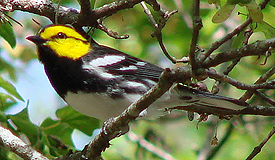 feeding on some nearby feeders. Yet another set of feeders had a Ladder-backed Woodpecker and a bright Indigo Bunting. We walked the trail up toward an overlook and within a few moments Gina heard another Golden-cheeked Warbler singing. The bird sang and foraged above our heads giving us cracking views and more great photo opportunities. Further on, a Blue-gray Gnatcatcher caught our attention as did an Orange-crowned Warbler. A Blue-headed Vireo called but did not show as we continued up the path. Near the top, Steve spotted a pair of Scott’s Orioles on the side of the hill and we all had good scope views of it. We could hear a Canyon Wren somewhere on a cliff above a small pond where Northern Rough-winged Swallows were feeding above the water. As we searched for the wren, singing Yellow-throated Warbler distracted us and gave excellent views. On the way down the trail, we caught a glimpse of a very vocal Red-eyed Vireo and Gina spotted a Rufous-crowned Sparrow singing in a tree – a sighting which was validated by Steve. We could hear an Eastern Wood-Pewee singing down the trail and quickly spotted it on top of one of the lost maples. After a picnic lunch, Ian spotted a large raptor soaring above the car park. We got good views of this bird and realized that it was an adult Common Black-Hawk – a very rare sighting for this area. Thrilled feeding on some nearby feeders. Yet another set of feeders had a Ladder-backed Woodpecker and a bright Indigo Bunting. We walked the trail up toward an overlook and within a few moments Gina heard another Golden-cheeked Warbler singing. The bird sang and foraged above our heads giving us cracking views and more great photo opportunities. Further on, a Blue-gray Gnatcatcher caught our attention as did an Orange-crowned Warbler. A Blue-headed Vireo called but did not show as we continued up the path. Near the top, Steve spotted a pair of Scott’s Orioles on the side of the hill and we all had good scope views of it. We could hear a Canyon Wren somewhere on a cliff above a small pond where Northern Rough-winged Swallows were feeding above the water. As we searched for the wren, singing Yellow-throated Warbler distracted us and gave excellent views. On the way down the trail, we caught a glimpse of a very vocal Red-eyed Vireo and Gina spotted a Rufous-crowned Sparrow singing in a tree – a sighting which was validated by Steve. We could hear an Eastern Wood-Pewee singing down the trail and quickly spotted it on top of one of the lost maples. After a picnic lunch, Ian spotted a large raptor soaring above the car park. We got good views of this bird and realized that it was an adult Common Black-Hawk – a very rare sighting for this area. Thrilled 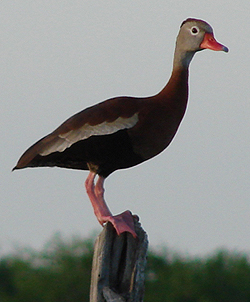 with our morning adventures, we moved on to Uvalde and stopped at the Fish Hatchery where we found Black-necked Stilt, Least Sandpiper, American Golden-Plover around the pools. We walked the levees and scanned more pools which yielded Black-bellied Whistling Duck, Pied-billed Grebe, Blue-winged Teal, and Ring-necked Duck. One larger pond held a number of waterfowl including White-faced Ibis, Ruddy Duck, Greater and Lesser Yellowlegs, Wilson’s Snipe, and a pair of Wilson’s Phalaropes, one of which was in bright breeding plumage. We continued along the track on the shore of the pond and saw Killdeer, Solitary Sandpiper, Least Sandpipers, and Wilson’s Snipe. We searched some other areas around Uvalde and Kay spotted a Wild Turkey along a fence. We turned the van around for a better look but by the time we got back, the bird had vanished. Steve jumped out and found it in a few seconds so we could all tick this species. We arrived back at Neal’s in the late afternoon and decided to check the feeders. The Cattle Guard feeders held Black-throated, Clay-colored, Field, Lincoln’s Sparrows, Lesser Goldfinch, a Long-billed Thrasher, Hooded Oriole, and an Inca Dove. Behind Cabin 61, we saw a few White-throated Sparrows, a nice White-eyed Vireo bathing in the drip pool, a Rufous-crowned Sparrow, more House Finches, and White-winged Doves. For dinner, Robbie cooked a wonderful chicken and beef brisket barbecue – the perfect end to a great day! with our morning adventures, we moved on to Uvalde and stopped at the Fish Hatchery where we found Black-necked Stilt, Least Sandpiper, American Golden-Plover around the pools. We walked the levees and scanned more pools which yielded Black-bellied Whistling Duck, Pied-billed Grebe, Blue-winged Teal, and Ring-necked Duck. One larger pond held a number of waterfowl including White-faced Ibis, Ruddy Duck, Greater and Lesser Yellowlegs, Wilson’s Snipe, and a pair of Wilson’s Phalaropes, one of which was in bright breeding plumage. We continued along the track on the shore of the pond and saw Killdeer, Solitary Sandpiper, Least Sandpipers, and Wilson’s Snipe. We searched some other areas around Uvalde and Kay spotted a Wild Turkey along a fence. We turned the van around for a better look but by the time we got back, the bird had vanished. Steve jumped out and found it in a few seconds so we could all tick this species. We arrived back at Neal’s in the late afternoon and decided to check the feeders. The Cattle Guard feeders held Black-throated, Clay-colored, Field, Lincoln’s Sparrows, Lesser Goldfinch, a Long-billed Thrasher, Hooded Oriole, and an Inca Dove. Behind Cabin 61, we saw a few White-throated Sparrows, a nice White-eyed Vireo bathing in the drip pool, a Rufous-crowned Sparrow, more House Finches, and White-winged Doves. For dinner, Robbie cooked a wonderful chicken and beef brisket barbecue – the perfect end to a great day!
Day 12 Friday 20th April
We had a long journey back to the upper Texas coast ahead of us today but instead of leaving Neal’s immediately after breakfast we decided to spend a little more time on the trails to get some new species. This proved to be a good idea as the Pecan Grove Trail produced Spotted Towhee, Canyon Towhee, another spectacular Painted Bunting, a Yellow-breasted Chat, White-crowned Sparrow, Lark Sparrow, Blue Grosbeak, and two Bell’s Vireos (one each for Ian and Ann). Back outside the cafe, we saw Couch’s Kingbird, Carolina Chickadee, Ladder-backed and Golden-fronted Woodpeckers. One last stop by the Frio River yielded a nice Canyon Wren spotted by Steve on a wire. We said goodbye to Neal’s, and headed up to Kerr Wildlife Management area in search of the rare and endangered Black-capped Vireo that had eluded us thus far. It wasn't long before Steve spotted a gorgeous male Black-capped Vireo singing in some thick scrub. We watched as the bird moved quickly among the branches and leaves and finally got good views of one in the open. As we enjoyed this handsome bird, we realized that there were several singing in the area. Pleased with our finds this morning, we set off on the long journey back to the coast. But our adventure wasn’t over yet! We still had High Island ahead of us!
Day 13 Saturday 21st April
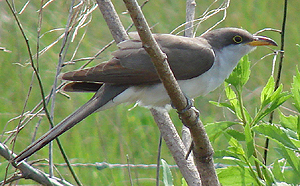 This morning started off very foggy as we took breakfast at the motel. Then we set off toward the famous migration watch point of High Island just a short drive up the road. In Boy Scouts Wood we found it was unexpectedly quiet but in one section we came across a Wood Thrush and then a confiding Grey-cheeked Thrush. There seemed to be more birds just outside the sanctuary along the road and as we stepped outside the gate, we found a flock of Indigo Buntings and a Rose-breasted Grosbeak. A Yellow-billed Cuckoo flew in and showed well, as did Red-eyed Vireo and a White-crowned Sparrow. Several Baltimore Orioles glowed in the morning light, and we got decent looks at our first Common Grackles. Moving on to Smiths Oak, we started with a bush that held confiding Gray Catbirds and several more Rose-breasted Grosbeaks, At a rookery on a small island just 30 yards from the trail we enjoyed fantastic views of nesting Great and Snowy Egrets, Roseate Spoonbills, Tricolored Heron, and Neotropic Cormorants. We enjoyed this show for awhile and noted a few American Alligators below the rookery. This morning started off very foggy as we took breakfast at the motel. Then we set off toward the famous migration watch point of High Island just a short drive up the road. In Boy Scouts Wood we found it was unexpectedly quiet but in one section we came across a Wood Thrush and then a confiding Grey-cheeked Thrush. There seemed to be more birds just outside the sanctuary along the road and as we stepped outside the gate, we found a flock of Indigo Buntings and a Rose-breasted Grosbeak. A Yellow-billed Cuckoo flew in and showed well, as did Red-eyed Vireo and a White-crowned Sparrow. Several Baltimore Orioles glowed in the morning light, and we got decent looks at our first Common Grackles. Moving on to Smiths Oak, we started with a bush that held confiding Gray Catbirds and several more Rose-breasted Grosbeaks, At a rookery on a small island just 30 yards from the trail we enjoyed fantastic views of nesting Great and Snowy Egrets, Roseate Spoonbills, Tricolored Heron, and Neotropic Cormorants. We enjoyed this show for awhile and noted a few American Alligators below the rookery.
We then returned to Boy Scouts Wood where we connected with a Philadelphia Vireo, Kentucky Warbler, Northern Waterthrush, several Scarlet Tanagers, and a Cerulean warbler. Nearby we took a barbeque lunch and then drove down to the Bolivar Peninsula to look at the sea which was rather windy and produced Royal Tern, Laughing Gulls, and Brown Pelicans. As we left a Blue Grosbeak was spotted on a fence.
Back at Boy Scout Woods, birds were coming in to bathe at the drip pool, including Tennessee and Prothonotary Warblers, Catbirds, and some thrushes. An Eastern Wood-Pewee showed well, as did a male Painted Bunting and numerous Orchard and Baltimore Orioles moved about the trees. This evening we were going on a “Rail Walk” so we went into town, bought some wellies and drove to Anahuac National Wildlife 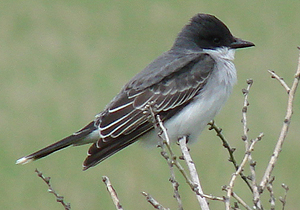 Refuge. Along the way, we noted Belted Kingfisher, Eastern Meadowlark, and Eastern Kingbird. At the reserve we spotted hundreds of shorebirds including Hudsonian Godwit, Long-billed and Short-billed Dowitcher, Willet, Semipalmated Plover, and Dunlin. In an area called the “Willows” we saw a Common Nighthawk perched in a tree as well as several Scarlet Tanagers, Red-eyed Vireo, another Common Nighthawk, Black-throated Green, Yellow and Magnolia Warblers. By now, it was time to return to the Visitor Center to join the rest of the group for the Yellow Rail walk. Once at the Yellow Rail prairie, the guide gave a short talk and we set off into the meadow to search for our quarry. We flushed up a Sora, some Seaside Sparrows, and a few Sedge Wrens and it was not long until we caught a glimpse of our first Yellow Rail. In all, we saw 7 Yellow Rails including one bird just a few feet away walking around on top of the grass. The guide called it one of the top ten best walks he has ever conducted and we were very pleased with our views. Refuge. Along the way, we noted Belted Kingfisher, Eastern Meadowlark, and Eastern Kingbird. At the reserve we spotted hundreds of shorebirds including Hudsonian Godwit, Long-billed and Short-billed Dowitcher, Willet, Semipalmated Plover, and Dunlin. In an area called the “Willows” we saw a Common Nighthawk perched in a tree as well as several Scarlet Tanagers, Red-eyed Vireo, another Common Nighthawk, Black-throated Green, Yellow and Magnolia Warblers. By now, it was time to return to the Visitor Center to join the rest of the group for the Yellow Rail walk. Once at the Yellow Rail prairie, the guide gave a short talk and we set off into the meadow to search for our quarry. We flushed up a Sora, some Seaside Sparrows, and a few Sedge Wrens and it was not long until we caught a glimpse of our first Yellow Rail. In all, we saw 7 Yellow Rails including one bird just a few feet away walking around on top of the grass. The guide called it one of the top ten best walks he has ever conducted and we were very pleased with our views.
After the official walk, we drove around Shoveler’s Pond to see what birds were active late in the day. We had nice looks at Whimbrel, several Eastern Kingbirds, Summer Tanagers, Forster’s Terns, Boat-tailed Grackles, and finally good views of two Marsh Wrens.
Day 14 Sunday 22nd April
Today we went back to Anahuac early which was a good move as we found two Least Bitterns in the reeds along the road. We also had excellent looks at Green Herons and a Common Nighthawk sitting on the ground in an open car park. We then had super views of a King Rail as well as Clapper and Sora Rails. We heard a Black Rail literally three feet away but never got a chance to see this mythical bird despite the valiant efforts of Steve who performed his own unique version of the rail dance. From here we went on to High Island to check on activity there. It was the mid-day lull so we had a chili lunch at the Methodist Church and drove on to Sabine Woods. We visited the Willows area first where we found Blue Grosbeak, Yellow Warbler, Yellow-throated and 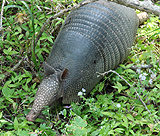 Red-eyed Vireo. We moved down the road to Sabine Woods which was much more active. We added Hermit Thrush and Veery to our list right away. We realized the need to be looking at the ground as well as the trees when a large Cottonmouth crossed the trail right in front of us. There were several Blue Grosbeaks showing well as were Yellow Warblers, Gray Catbird, Rose-breasted Grosbeak, Summer Tanager, Red-eyed Vireos, Swainson’s Thrush, Brown Thrasher, Kentucky Warbler, an elusive Ovenbird. There were several Armadillos here and we had excellent looks at one from the boardwalk. An Orange-crowned Warbler earned a dance from Robbie. Our favorite spot here was the small drip pond which held Hooded Warbler, American Redstart,
Prothonotary Warbler, Carolina Wren, Tennessee Warbler, Black-throated Green, and more Yellow Warblers. A Northern Waterthrush had a duel with a Cottonmouth as it entered the pond and disappeared in the debris. Back out on the boardwalk, we found a nice Bay-breasted Warbler foraging in the trees above our heads. On the ground nearby, an Eastern Towhee showed briefly. We enjoyed our visit to this wildlife filled area. As the sun set, we drove back to Winnie for another fine dinner at Al-T’s. Red-eyed Vireo. We moved down the road to Sabine Woods which was much more active. We added Hermit Thrush and Veery to our list right away. We realized the need to be looking at the ground as well as the trees when a large Cottonmouth crossed the trail right in front of us. There were several Blue Grosbeaks showing well as were Yellow Warblers, Gray Catbird, Rose-breasted Grosbeak, Summer Tanager, Red-eyed Vireos, Swainson’s Thrush, Brown Thrasher, Kentucky Warbler, an elusive Ovenbird. There were several Armadillos here and we had excellent looks at one from the boardwalk. An Orange-crowned Warbler earned a dance from Robbie. Our favorite spot here was the small drip pond which held Hooded Warbler, American Redstart,
Prothonotary Warbler, Carolina Wren, Tennessee Warbler, Black-throated Green, and more Yellow Warblers. A Northern Waterthrush had a duel with a Cottonmouth as it entered the pond and disappeared in the debris. Back out on the boardwalk, we found a nice Bay-breasted Warbler foraging in the trees above our heads. On the ground nearby, an Eastern Towhee showed briefly. We enjoyed our visit to this wildlife filled area. As the sun set, we drove back to Winnie for another fine dinner at Al-T’s.
Day 15 Monday 23rd April
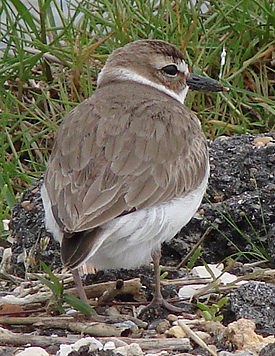 This morning we went out early to try and secure a target species. As we arrived at our site near a salt marsh, the birds were already singing and after a few anxious moments and some concentration most of the group got superb views of a close Nelson’s Sharp-tailed Sparrow. Nearby we had incredible close views of five Clapper Rails and some of the regular shore birds including Willet and Lesser Yellowlegs that we were now used to seeing on a daily basis. From here we drove toward Bolivar flats. Along the way, we passed an immature White-tailed Hawk on a post. On the beach we found Piping and Wilson’s Plovers, Western Sandpipers, lots of Sanderlings, a tern roost with Forster's, Common, Least, Royal, Caspian, Sandwich Terns and a couple of Reddish Egrets. A Great Blue Heron succeeded in eating an enormous fish that was so big we all thought it would be impossible. The flats were teeming with activity with a variety of species including Black-bellied Plover, Brown Pelican, gorgeous American Avocets, Black Skimmers, Caspian Terns, and Whimbrel. Two Horned Larks showed briefly at the scrub line. In the scrub we enjoyed super views of a LeConte’s Sparrow which sat in a bush and allowed several photos. We saw a large flock of birds following a boat and amongst them terns and Laughing Gulls and a nice Bonaparte’s Gull – the first and only for the trip. We checked some marsh areas and found Pied-billed Grebe, Blue-winged Teal and a Raccoon. On our way out, we stopped at Rollover Pass
where we found White Pelicans, more Black Skimmers, and several Mottled Ducks. Back at Boy Scout Woods, we walked to the marsh at the edge of the reserve and found a lovely Purple Gallinule. Blue grosbeaks were present as was a vocal Common Yellowthroat. In the forest, an elusive Ovenbird gave us the run around but was eventually seen by all. At the drip pond, a Brown Thrasher bathed as did Kentucky, Yellow and Tennessee Warblers. Summer and Scarlet Tanagers were all around as were Rose-breasted Grosbeaks. Carolina Wren, Swainson’s Thrush, Veery, and Ruby-throated hummingbird rounded out the cast of characters here. On our way back to Winnie, we stopped at Anahuac where we saw a few Least Terns at the entrance to the Shoveler Pond Trail. On the boardwalk into Shoveler’s Pond, we had good looks at our first Swamp Sparrow. As the daylight faded, a Common Nighthawk flew over. Fulvous Whistling Ducks were there as well as some vocal Marsh Wrens. This morning we went out early to try and secure a target species. As we arrived at our site near a salt marsh, the birds were already singing and after a few anxious moments and some concentration most of the group got superb views of a close Nelson’s Sharp-tailed Sparrow. Nearby we had incredible close views of five Clapper Rails and some of the regular shore birds including Willet and Lesser Yellowlegs that we were now used to seeing on a daily basis. From here we drove toward Bolivar flats. Along the way, we passed an immature White-tailed Hawk on a post. On the beach we found Piping and Wilson’s Plovers, Western Sandpipers, lots of Sanderlings, a tern roost with Forster's, Common, Least, Royal, Caspian, Sandwich Terns and a couple of Reddish Egrets. A Great Blue Heron succeeded in eating an enormous fish that was so big we all thought it would be impossible. The flats were teeming with activity with a variety of species including Black-bellied Plover, Brown Pelican, gorgeous American Avocets, Black Skimmers, Caspian Terns, and Whimbrel. Two Horned Larks showed briefly at the scrub line. In the scrub we enjoyed super views of a LeConte’s Sparrow which sat in a bush and allowed several photos. We saw a large flock of birds following a boat and amongst them terns and Laughing Gulls and a nice Bonaparte’s Gull – the first and only for the trip. We checked some marsh areas and found Pied-billed Grebe, Blue-winged Teal and a Raccoon. On our way out, we stopped at Rollover Pass
where we found White Pelicans, more Black Skimmers, and several Mottled Ducks. Back at Boy Scout Woods, we walked to the marsh at the edge of the reserve and found a lovely Purple Gallinule. Blue grosbeaks were present as was a vocal Common Yellowthroat. In the forest, an elusive Ovenbird gave us the run around but was eventually seen by all. At the drip pond, a Brown Thrasher bathed as did Kentucky, Yellow and Tennessee Warblers. Summer and Scarlet Tanagers were all around as were Rose-breasted Grosbeaks. Carolina Wren, Swainson’s Thrush, Veery, and Ruby-throated hummingbird rounded out the cast of characters here. On our way back to Winnie, we stopped at Anahuac where we saw a few Least Terns at the entrance to the Shoveler Pond Trail. On the boardwalk into Shoveler’s Pond, we had good looks at our first Swamp Sparrow. As the daylight faded, a Common Nighthawk flew over. Fulvous Whistling Ducks were there as well as some vocal Marsh Wrens.
Day 16 Tuesday 24th April
On our last morning in Texas, we headed out to Anahuac for a last try for the American Bittern that had been eluding us. We searched along Shoveler’s Pond and found more Least Bitterns but no American Bittern. So we took the road out toward the Yellow Rail prairie in the hopes that we would find our bird. As we slowed down to round a sharp corner, Steve saw a bittern flying out in the marsh. We pulled over and walked along a waterway as far as we could while keeping a watch for alligators and snakes. To our delight, the bird flew up again and we all got great flight views of it. As we made our way back to the vehicle, Gina shouted, “Behind us!” and we turned to see the Bittern had flown even closer. We worked hard for this bird and were pleased with the excellent views we finally had.
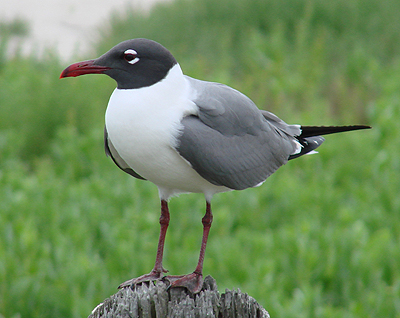 It was time to head for the airport so we checked out of the hotel and said goodbye to Winnie. We drove north to a park area that held Fish Crow, our last new species. We enjoyed our final picnic lunch in the company of Cattle Egrets, Laughing Gulls, and Yellow-crowned Night-Herons. A nearby lake held a number of American Coot as well. On our way back to Houston, we stopped at another lake area which held herons, egrets, and a number of nice dragonflies and our last warbler for the trip - a Northern Parula. It was time to head for the airport so we checked out of the hotel and said goodbye to Winnie. We drove north to a park area that held Fish Crow, our last new species. We enjoyed our final picnic lunch in the company of Cattle Egrets, Laughing Gulls, and Yellow-crowned Night-Herons. A nearby lake held a number of American Coot as well. On our way back to Houston, we stopped at another lake area which held herons, egrets, and a number of nice dragonflies and our last warbler for the trip - a Northern Parula.
On behalf of Steve Bird and myself, I want to thank the people in our group for an excellent trip. We enjoyed fabulous looks at scores of great birds during our journey and we shared so many wonderful experiences and laughs while enjoying the magic of spring migration in Texas. I look forward to when our paths cross again. Thank you! |

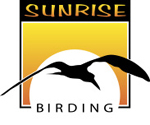 In association with Birdseekers
In association with Birdseekers 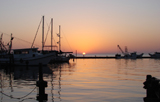
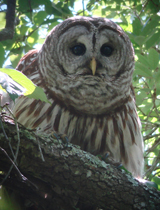
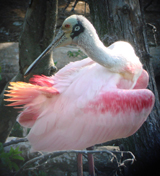
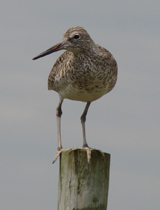
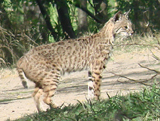
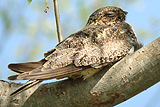
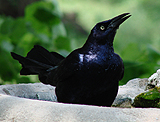
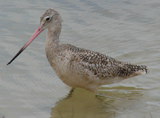

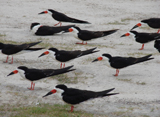
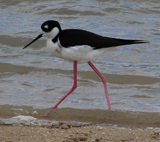

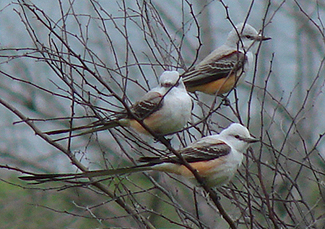
 Our next stop was a Cliff Swallow colony under a bridge along the road. Several birds were coming in and out of mud nests often stopping in the entrance hole so we could get good views of their head features. A few Barn Swallows were also around. We moved on to Brazos Bend State Park where we had our picnic lunch next to a lovely lake with views of Roseate Spoonbills in the distance, Black-bellied Whistling Duck, American Coot, Pied-billed Grebe, Great Egret, Snowy Egret, and a small American Alligator. Two young White Ibis foraged on the edge of the lake. After lunch we investigated the area and Steve soon found a pair of Barred Owls, one of which sat in plain view in the branches of a large oak giving us spectacular looks. After watching the owl for several minutes, we realized there were other birds in the forest including a lovely male Northern Parula.
Our next stop was a Cliff Swallow colony under a bridge along the road. Several birds were coming in and out of mud nests often stopping in the entrance hole so we could get good views of their head features. A few Barn Swallows were also around. We moved on to Brazos Bend State Park where we had our picnic lunch next to a lovely lake with views of Roseate Spoonbills in the distance, Black-bellied Whistling Duck, American Coot, Pied-billed Grebe, Great Egret, Snowy Egret, and a small American Alligator. Two young White Ibis foraged on the edge of the lake. After lunch we investigated the area and Steve soon found a pair of Barred Owls, one of which sat in plain view in the branches of a large oak giving us spectacular looks. After watching the owl for several minutes, we realized there were other birds in the forest including a lovely male Northern Parula. While crossing the bay, we watched a Common Loon, several Double-crested Cormorants diving, and Least and Sandwich Terns fishing in the open water. We reached the first island in the bay and slowed down to make our way through a channel next to a rock jetty. Inside the jetty were sand flats that held several Black Skimmers, Semipalmated Plover, Semipalmated Sandpiper, Sanderlings, and American Avocet. A few Least Sandpipers foraged on the rock jetty while an American Oystercatcher stood on the opposite side of the channel. In the distance, we saw more Bottle-nosed Dolphins porpoising in the water. Just inside the channel, we spotted our first Whooping Cranes in the distance near some White-tailed Deer. There were several sand bars along the channel that held Black-bellied Plovers, Sanderlings, and Forster’s Terns. On the shores of a barrier island, two Marbled Godwits foraged with two Willets. A small group of Black-bellied Whistling Ducks flew over and we spotted Ring-billed Gull on one of the outcrops in the channel. Two Whimbrels flew out over the island and we could see a number of Scissor-tailed Flycatchers perched on the low vegetation. At one point, Captain Tommy steered us toward two Seaside Sparrows perched and singing on stalks of marsh grass giving us good views. The inlets were lined with Snowy Egrets and we spotted a few Mottled Ducks as well. A lovely flock of White-faced Ibis flew by over the marsh with the light showing their facial patterns. An Osprey came quite close to the boat giving good views. However we strained to see three more Whooping Cranes in the distance. Out on the marsh, a Northern Harrier perched up on a stick in the marsh and while another flew over the marsh in the distance. As we turned back, Steve spotted four Whooping Cranes flying which allowed us fantastic views in the morning light. Pleased with decent views of these endangered birds, we moved on to a nesting island for herons and egrets. Roseate Spoonbills were the show stoppers here with their bright pink wings and orange tails. A number of Reddish Egrets were perched in the trees at one end of the island while Great Blue Herons and Snowy Egrets tended their nests on the middle of the island. We enjoyed the rookery show for several minutes commenting on the antics of the birds. Then, Steve spotted a group of five more Whooping Cranes flying by and in the next few minutes several more cranes appeared and we end up with an amazing total of 27 cranes for the day. The return trip to the mainland, yielded several more terns and a female Red-breasted Merganser. Back at the hotel, we checked the garden where two Fox Squirrels were tending their nest. Two Indigo Buntings worked the taller trees as did a bright Orange-crowned Warbler and a few Mourning Doves.
While crossing the bay, we watched a Common Loon, several Double-crested Cormorants diving, and Least and Sandwich Terns fishing in the open water. We reached the first island in the bay and slowed down to make our way through a channel next to a rock jetty. Inside the jetty were sand flats that held several Black Skimmers, Semipalmated Plover, Semipalmated Sandpiper, Sanderlings, and American Avocet. A few Least Sandpipers foraged on the rock jetty while an American Oystercatcher stood on the opposite side of the channel. In the distance, we saw more Bottle-nosed Dolphins porpoising in the water. Just inside the channel, we spotted our first Whooping Cranes in the distance near some White-tailed Deer. There were several sand bars along the channel that held Black-bellied Plovers, Sanderlings, and Forster’s Terns. On the shores of a barrier island, two Marbled Godwits foraged with two Willets. A small group of Black-bellied Whistling Ducks flew over and we spotted Ring-billed Gull on one of the outcrops in the channel. Two Whimbrels flew out over the island and we could see a number of Scissor-tailed Flycatchers perched on the low vegetation. At one point, Captain Tommy steered us toward two Seaside Sparrows perched and singing on stalks of marsh grass giving us good views. The inlets were lined with Snowy Egrets and we spotted a few Mottled Ducks as well. A lovely flock of White-faced Ibis flew by over the marsh with the light showing their facial patterns. An Osprey came quite close to the boat giving good views. However we strained to see three more Whooping Cranes in the distance. Out on the marsh, a Northern Harrier perched up on a stick in the marsh and while another flew over the marsh in the distance. As we turned back, Steve spotted four Whooping Cranes flying which allowed us fantastic views in the morning light. Pleased with decent views of these endangered birds, we moved on to a nesting island for herons and egrets. Roseate Spoonbills were the show stoppers here with their bright pink wings and orange tails. A number of Reddish Egrets were perched in the trees at one end of the island while Great Blue Herons and Snowy Egrets tended their nests on the middle of the island. We enjoyed the rookery show for several minutes commenting on the antics of the birds. Then, Steve spotted a group of five more Whooping Cranes flying by and in the next few minutes several more cranes appeared and we end up with an amazing total of 27 cranes for the day. The return trip to the mainland, yielded several more terns and a female Red-breasted Merganser. Back at the hotel, we checked the garden where two Fox Squirrels were tending their nest. Two Indigo Buntings worked the taller trees as did a bright Orange-crowned Warbler and a few Mourning Doves.  Back out along the street, Gina spotted a Chuck-Wills-Widow perched on the horizontal branch of a tree. After excellent views of this difficult species, Ian alerted us to a nearby waterthrush which turned out to be a Louisiana Waterthrush. A Broad-winged Hawk dashed through the trees and gave us a quick view. Heading south we made a short detour to see Black Skimmers at the town beach. We were able to get incredibly close to hundreds of these magnificent birds and watch them skim in a large rainwater puddle. In the same pool, Short-billed Dowitchers, Least Sandpipers, Semipalmated Sandpipers, Lesser Yellowlegs bathed and we were pleased with excellent views of all of these species. Close by, a female Lesser Scaup, several American Coot, Mallard, Mottled Duck and a very obliging Marbled Godwit showed well. As we left the park, we watched the antics of a Savannah Sparrow noting the field marks for future comparisons with other sparrows. Continuing on to a ferry crossing, we saw a Bronzed Cowbird displaying on the side of the road and more Savannah Sparrows. As we crossed the channel, a couple of Bottle-nosed Dolphins were spotted.
Back out along the street, Gina spotted a Chuck-Wills-Widow perched on the horizontal branch of a tree. After excellent views of this difficult species, Ian alerted us to a nearby waterthrush which turned out to be a Louisiana Waterthrush. A Broad-winged Hawk dashed through the trees and gave us a quick view. Heading south we made a short detour to see Black Skimmers at the town beach. We were able to get incredibly close to hundreds of these magnificent birds and watch them skim in a large rainwater puddle. In the same pool, Short-billed Dowitchers, Least Sandpipers, Semipalmated Sandpipers, Lesser Yellowlegs bathed and we were pleased with excellent views of all of these species. Close by, a female Lesser Scaup, several American Coot, Mallard, Mottled Duck and a very obliging Marbled Godwit showed well. As we left the park, we watched the antics of a Savannah Sparrow noting the field marks for future comparisons with other sparrows. Continuing on to a ferry crossing, we saw a Bronzed Cowbird displaying on the side of the road and more Savannah Sparrows. As we crossed the channel, a couple of Bottle-nosed Dolphins were spotted.  everything. Near the parking lot were Ruby-throated Hummingbirds, a male Hooded Warbler, quite a few Yellow-rumped Warblers, Blue-winged Warbler, and White-eyed Vireo. On the boardwalk we got very close to three Wilson’s Snipe, Stilt Sandpiper, Long-billed Dowitchers, Black-necked Stilt, Least, Western and Semipalmated Sandpipers. Ducks included Green-winged Teal, Northern Pintail, Blue-winged Teal, Northern Shoveler, a group of Ruddy Ducks, and two Cinnamon Teal. A large flock of American Avocets looked superb especially when they all took flight. Several Nutria inhabited the area and as a finale to our excellent day we got close-up looks at a smart-looking Sora.
everything. Near the parking lot were Ruby-throated Hummingbirds, a male Hooded Warbler, quite a few Yellow-rumped Warblers, Blue-winged Warbler, and White-eyed Vireo. On the boardwalk we got very close to three Wilson’s Snipe, Stilt Sandpiper, Long-billed Dowitchers, Black-necked Stilt, Least, Western and Semipalmated Sandpipers. Ducks included Green-winged Teal, Northern Pintail, Blue-winged Teal, Northern Shoveler, a group of Ruddy Ducks, and two Cinnamon Teal. A large flock of American Avocets looked superb especially when they all took flight. Several Nutria inhabited the area and as a finale to our excellent day we got close-up looks at a smart-looking Sora.  We continued on towards Corpus Christi with some stops along the way for Merlin, Peregrine Falcon, Upland Sandpiper, Long-billed Curlew, Marbled Godwit, Tricolored Herons. One open area held Eastern Meadowlarks,
We continued on towards Corpus Christi with some stops along the way for Merlin, Peregrine Falcon, Upland Sandpiper, Long-billed Curlew, Marbled Godwit, Tricolored Herons. One open area held Eastern Meadowlarks,  several Lincoln’s Sparrows. On one end, a Yellow-billed Cuckoo gave close views as did several Orchard Orioles, a few Ruby-crowned Kinglets showing their ruby crowns, Scissor-tailed Flycatchers, Lark Sparrows, a nice Tennessee Warbler, lots of cowbirds and blackbirds. One particular tree in a garden area had several birds including Couch’s Kingbird, Yellow-breasted Chat, Nashville Warbler, and some Western Kingbirds.
several Lincoln’s Sparrows. On one end, a Yellow-billed Cuckoo gave close views as did several Orchard Orioles, a few Ruby-crowned Kinglets showing their ruby crowns, Scissor-tailed Flycatchers, Lark Sparrows, a nice Tennessee Warbler, lots of cowbirds and blackbirds. One particular tree in a garden area had several birds including Couch’s Kingbird, Yellow-breasted Chat, Nashville Warbler, and some Western Kingbirds.  We took the wildlife drive stopping at several places for Mottled Duck, Gadwall, White-faced Ibis, White Ibis, American Alligator, Northern Shoveler, Fulvous Whistling Duck, American Coot, and many Willets. Further on, our first Greater Roadrunner crossed the road much to Robbie’s delight. As we rounded the corner toward the bay, a Golden-fronted Woodpecker was heard calling and briefly showed. Several Osprey were seen – some hovering over the water and one eating a fish on a sandy beach. We continued on the loop road until we saw another Roadrunner to which Robyn again exclaimed, “Yabba-dabba-doo!”. Several Horned Larks were spotted along the road. We stopped at the Verdin corner to try to get a look. After a few minutes, a gorgeous male perched at eye level on a bush not three yards away giving us excellent views.
We took the wildlife drive stopping at several places for Mottled Duck, Gadwall, White-faced Ibis, White Ibis, American Alligator, Northern Shoveler, Fulvous Whistling Duck, American Coot, and many Willets. Further on, our first Greater Roadrunner crossed the road much to Robbie’s delight. As we rounded the corner toward the bay, a Golden-fronted Woodpecker was heard calling and briefly showed. Several Osprey were seen – some hovering over the water and one eating a fish on a sandy beach. We continued on the loop road until we saw another Roadrunner to which Robyn again exclaimed, “Yabba-dabba-doo!”. Several Horned Larks were spotted along the road. We stopped at the Verdin corner to try to get a look. After a few minutes, a gorgeous male perched at eye level on a bush not three yards away giving us excellent views.  Center with hundreds of revving motorcycles. We approached the birding area wondering what we would find and, to our delight, there were several warblers and orioles actively feeding in the vegetation. Once again, we got close looks at Yellow-throated and Prothonotary Warbler, Northern Parula, and Ruby-throated Hummingbird. New species included Blue-headed Vireo and Northern Waterthrush. A Swainson’s Warbler was reported in the thick brush so we searched for awhile eventually getting cracking looks at this skulking little bird. What a way to end a great birding day! We left the convention center wondering if the bikers had any idea what was going on in the natural area behind. On the way out of South Padre, we found a lovely
restaurant for dinner.
Center with hundreds of revving motorcycles. We approached the birding area wondering what we would find and, to our delight, there were several warblers and orioles actively feeding in the vegetation. Once again, we got close looks at Yellow-throated and Prothonotary Warbler, Northern Parula, and Ruby-throated Hummingbird. New species included Blue-headed Vireo and Northern Waterthrush. A Swainson’s Warbler was reported in the thick brush so we searched for awhile eventually getting cracking looks at this skulking little bird. What a way to end a great birding day! We left the convention center wondering if the bikers had any idea what was going on in the natural area behind. On the way out of South Padre, we found a lovely
restaurant for dinner.  Visitor’s Center. We were soon treated to our first views of Buff-bellied Hummingbird and White-tipped Doves. In the forest, we got good looks at Olive Sparrows and several of Golden-fronted Woodpeckers. A Rose-breasted Grosbeak showed briefly as we made our way to a pond where we enjoyed Least and Pied-billed Grebes, Prothonotary Warbler, and a nice Ladder-backed Woodpecker. We
then drove to Santa Ana Wildlife Refuge. Not far into the park we enjoyed Altamira Oriole, Brown-crested Flycatcher, and Couch’s Kingbird. Next up was a fabulous Northern Beardless Tyrannulet. We climbed a tower lookout and saw several kingbirds but very little else in the heat of the day. On another trail we came across a stunning bobcat which did not run off and allowed us unbelievable views before slowly walking away. On the ponds were Black-bellied Whistling Ducks, American Wigeon, White-faced Ibis, Black-necked Stilt, Gadwall, and a scope view of a Green Kingfisher. Overhead, a Harris’s Hawk soared by. We continued on the River Trail which was quiet and afforded
obscured views of the Rio Grande which forms the border between Texas and Mexico.
Visitor’s Center. We were soon treated to our first views of Buff-bellied Hummingbird and White-tipped Doves. In the forest, we got good looks at Olive Sparrows and several of Golden-fronted Woodpeckers. A Rose-breasted Grosbeak showed briefly as we made our way to a pond where we enjoyed Least and Pied-billed Grebes, Prothonotary Warbler, and a nice Ladder-backed Woodpecker. We
then drove to Santa Ana Wildlife Refuge. Not far into the park we enjoyed Altamira Oriole, Brown-crested Flycatcher, and Couch’s Kingbird. Next up was a fabulous Northern Beardless Tyrannulet. We climbed a tower lookout and saw several kingbirds but very little else in the heat of the day. On another trail we came across a stunning bobcat which did not run off and allowed us unbelievable views before slowly walking away. On the ponds were Black-bellied Whistling Ducks, American Wigeon, White-faced Ibis, Black-necked Stilt, Gadwall, and a scope view of a Green Kingfisher. Overhead, a Harris’s Hawk soared by. We continued on the River Trail which was quiet and afforded
obscured views of the Rio Grande which forms the border between Texas and Mexico.  Back in McAllen, we drove to the obligatory sewage ponds where we saw several Least Sandpipers, a few Semipalmateds, a Pectoral Sandpiper, a few Baird’s Sandpipers, Lesser Yellowlegs, two Gull-billed Terns. The odor was everything one might imagine but the birds were fabulous so we held our breaths! We headed back to our hotel for a siesta and then an early dinner so that we could get back to Bentsen around dusk. As we pulled in to the park we jumped out of the bus as there were about 10 Mississippi Kites drifting low overhead. As we watched these birds, more appeared and we counted nearly 100 including kites - many very low allowing excellent views. We walked into the park and soon located a singing Clay-colored Robin showing exceptionally well in a dead tree. Further on, we heard a Ferruginous Pygmy-Owl which after a game of call and seek, we eventually tracked it down to three feet off the ground in a tiny bush. Once again we enjoyed superb views of another great bird.
Back in McAllen, we drove to the obligatory sewage ponds where we saw several Least Sandpipers, a few Semipalmateds, a Pectoral Sandpiper, a few Baird’s Sandpipers, Lesser Yellowlegs, two Gull-billed Terns. The odor was everything one might imagine but the birds were fabulous so we held our breaths! We headed back to our hotel for a siesta and then an early dinner so that we could get back to Bentsen around dusk. As we pulled in to the park we jumped out of the bus as there were about 10 Mississippi Kites drifting low overhead. As we watched these birds, more appeared and we counted nearly 100 including kites - many very low allowing excellent views. We walked into the park and soon located a singing Clay-colored Robin showing exceptionally well in a dead tree. Further on, we heard a Ferruginous Pygmy-Owl which after a game of call and seek, we eventually tracked it down to three feet off the ground in a tiny bush. Once again we enjoyed superb views of another great bird.  immaculate Yellow-headed Blackbirds. Down by the river, we spotted Double-crested Cormorants, Plain Chachalacas, and a couple of Mottled Ducks. Leaving here we stopped for our first Ash-throated Flycatcher. We drove along to our next site and almost collided with a kamikaze Roadrunner. A lovely Curve-billed Thrasher posed for us while we recovered from the trauma of the near miss with the Roadrunner. We walked the campground finding more thrashers and a nice Orange-crowned Warbler, Bewick’s Wrens were very vocal and showy. We also saw Black-throated Sparrows and several Pyrrhuloxias in the scrub as well as an accommodating Verdin on a wire. Bell’s Vireo sang but stayed well hidden. A White-crowned Sparrow showed well and as we were about to leave, a Peregrine Falcon flew by.
immaculate Yellow-headed Blackbirds. Down by the river, we spotted Double-crested Cormorants, Plain Chachalacas, and a couple of Mottled Ducks. Leaving here we stopped for our first Ash-throated Flycatcher. We drove along to our next site and almost collided with a kamikaze Roadrunner. A lovely Curve-billed Thrasher posed for us while we recovered from the trauma of the near miss with the Roadrunner. We walked the campground finding more thrashers and a nice Orange-crowned Warbler, Bewick’s Wrens were very vocal and showy. We also saw Black-throated Sparrows and several Pyrrhuloxias in the scrub as well as an accommodating Verdin on a wire. Bell’s Vireo sang but stayed well hidden. A White-crowned Sparrow showed well and as we were about to leave, a Peregrine Falcon flew by. was quiet except for a group of Cave Swallows flying around. A Rock Wren called from the other side of the seating area. As the sun began to set, the first bats started to emerge from the cave flying diagonally past us. Shortly after the bats started, a Merlin flew in and took one of the unsuspecting creatures. For more than 30 minutes, Mexican Free-tailed Bats streamed out of the cave against the sunset giving an unforgettable and exciting show. We walked back in the dark under starlit skies and next to fields sparkling with fire flies. A Chuck-wills-widow and a Whippoorwill serenaded us as we made our way back to the vehicles. This evening was indeed magical and the perfect end to another great day.
was quiet except for a group of Cave Swallows flying around. A Rock Wren called from the other side of the seating area. As the sun began to set, the first bats started to emerge from the cave flying diagonally past us. Shortly after the bats started, a Merlin flew in and took one of the unsuspecting creatures. For more than 30 minutes, Mexican Free-tailed Bats streamed out of the cave against the sunset giving an unforgettable and exciting show. We walked back in the dark under starlit skies and next to fields sparkling with fire flies. A Chuck-wills-widow and a Whippoorwill serenaded us as we made our way back to the vehicles. This evening was indeed magical and the perfect end to another great day. with our morning adventures, we moved on to Uvalde and stopped at the Fish Hatchery where we found Black-necked Stilt, Least Sandpiper, American Golden-Plover around the pools. We walked the levees and scanned more pools which yielded Black-bellied Whistling Duck, Pied-billed Grebe, Blue-winged Teal, and Ring-necked Duck. One larger pond held a number of waterfowl including White-faced Ibis, Ruddy Duck, Greater and Lesser Yellowlegs, Wilson’s Snipe, and a pair of Wilson’s Phalaropes, one of which was in bright breeding plumage. We continued along the track on the shore of the pond and saw Killdeer, Solitary Sandpiper, Least Sandpipers, and Wilson’s Snipe. We searched some other areas around Uvalde and Kay spotted a Wild Turkey along a fence. We turned the van around for a better look but by the time we got back, the bird had vanished. Steve jumped out and found it in a few seconds so we could all tick this species. We arrived back at Neal’s in the late afternoon and decided to check the feeders. The Cattle Guard feeders held Black-throated, Clay-colored, Field, Lincoln’s Sparrows, Lesser Goldfinch, a Long-billed Thrasher, Hooded Oriole, and an Inca Dove. Behind Cabin 61, we saw a few White-throated Sparrows, a nice White-eyed Vireo bathing in the drip pool, a Rufous-crowned Sparrow, more House Finches, and White-winged Doves. For dinner, Robbie cooked a wonderful chicken and beef brisket barbecue – the perfect end to a great day!
with our morning adventures, we moved on to Uvalde and stopped at the Fish Hatchery where we found Black-necked Stilt, Least Sandpiper, American Golden-Plover around the pools. We walked the levees and scanned more pools which yielded Black-bellied Whistling Duck, Pied-billed Grebe, Blue-winged Teal, and Ring-necked Duck. One larger pond held a number of waterfowl including White-faced Ibis, Ruddy Duck, Greater and Lesser Yellowlegs, Wilson’s Snipe, and a pair of Wilson’s Phalaropes, one of which was in bright breeding plumage. We continued along the track on the shore of the pond and saw Killdeer, Solitary Sandpiper, Least Sandpipers, and Wilson’s Snipe. We searched some other areas around Uvalde and Kay spotted a Wild Turkey along a fence. We turned the van around for a better look but by the time we got back, the bird had vanished. Steve jumped out and found it in a few seconds so we could all tick this species. We arrived back at Neal’s in the late afternoon and decided to check the feeders. The Cattle Guard feeders held Black-throated, Clay-colored, Field, Lincoln’s Sparrows, Lesser Goldfinch, a Long-billed Thrasher, Hooded Oriole, and an Inca Dove. Behind Cabin 61, we saw a few White-throated Sparrows, a nice White-eyed Vireo bathing in the drip pool, a Rufous-crowned Sparrow, more House Finches, and White-winged Doves. For dinner, Robbie cooked a wonderful chicken and beef brisket barbecue – the perfect end to a great day!  This morning started off very foggy as we took breakfast at the motel. Then we set off toward the famous migration watch point of High Island just a short drive up the road. In Boy Scouts Wood we found it was unexpectedly quiet but in one section we came across a Wood Thrush and then a confiding Grey-cheeked Thrush. There seemed to be more birds just outside the sanctuary along the road and as we stepped outside the gate, we found a flock of Indigo Buntings and a Rose-breasted Grosbeak. A Yellow-billed Cuckoo flew in and showed well, as did Red-eyed Vireo and a White-crowned Sparrow. Several Baltimore Orioles glowed in the morning light, and we got decent looks at our first Common Grackles. Moving on to Smiths Oak, we started with a bush that held confiding Gray Catbirds and several more Rose-breasted Grosbeaks, At a rookery on a small island just 30 yards from the trail we enjoyed fantastic views of nesting Great and Snowy Egrets, Roseate Spoonbills, Tricolored Heron, and Neotropic Cormorants. We enjoyed this show for awhile and noted a few American Alligators below the rookery.
This morning started off very foggy as we took breakfast at the motel. Then we set off toward the famous migration watch point of High Island just a short drive up the road. In Boy Scouts Wood we found it was unexpectedly quiet but in one section we came across a Wood Thrush and then a confiding Grey-cheeked Thrush. There seemed to be more birds just outside the sanctuary along the road and as we stepped outside the gate, we found a flock of Indigo Buntings and a Rose-breasted Grosbeak. A Yellow-billed Cuckoo flew in and showed well, as did Red-eyed Vireo and a White-crowned Sparrow. Several Baltimore Orioles glowed in the morning light, and we got decent looks at our first Common Grackles. Moving on to Smiths Oak, we started with a bush that held confiding Gray Catbirds and several more Rose-breasted Grosbeaks, At a rookery on a small island just 30 yards from the trail we enjoyed fantastic views of nesting Great and Snowy Egrets, Roseate Spoonbills, Tricolored Heron, and Neotropic Cormorants. We enjoyed this show for awhile and noted a few American Alligators below the rookery.  Refuge. Along the way, we noted Belted Kingfisher, Eastern Meadowlark, and Eastern Kingbird. At the reserve we spotted hundreds of shorebirds including Hudsonian Godwit, Long-billed and Short-billed Dowitcher, Willet, Semipalmated Plover, and Dunlin. In an area called the “Willows” we saw a Common Nighthawk perched in a tree as well as several Scarlet Tanagers, Red-eyed Vireo, another Common Nighthawk, Black-throated Green, Yellow and Magnolia Warblers. By now, it was time to return to the Visitor Center to join the rest of the group for the Yellow Rail walk. Once at the Yellow Rail prairie, the guide gave a short talk and we set off into the meadow to search for our quarry. We flushed up a Sora, some Seaside Sparrows, and a few Sedge Wrens and it was not long until we caught a glimpse of our first Yellow Rail. In all, we saw 7 Yellow Rails including one bird just a few feet away walking around on top of the grass. The guide called it one of the top ten best walks he has ever conducted and we were very pleased with our views.
Refuge. Along the way, we noted Belted Kingfisher, Eastern Meadowlark, and Eastern Kingbird. At the reserve we spotted hundreds of shorebirds including Hudsonian Godwit, Long-billed and Short-billed Dowitcher, Willet, Semipalmated Plover, and Dunlin. In an area called the “Willows” we saw a Common Nighthawk perched in a tree as well as several Scarlet Tanagers, Red-eyed Vireo, another Common Nighthawk, Black-throated Green, Yellow and Magnolia Warblers. By now, it was time to return to the Visitor Center to join the rest of the group for the Yellow Rail walk. Once at the Yellow Rail prairie, the guide gave a short talk and we set off into the meadow to search for our quarry. We flushed up a Sora, some Seaside Sparrows, and a few Sedge Wrens and it was not long until we caught a glimpse of our first Yellow Rail. In all, we saw 7 Yellow Rails including one bird just a few feet away walking around on top of the grass. The guide called it one of the top ten best walks he has ever conducted and we were very pleased with our views.  This morning we went out early to try and secure a target species. As we arrived at our site near a salt marsh, the birds were already singing and after a few anxious moments and some concentration most of the group got superb views of a close Nelson’s Sharp-tailed Sparrow. Nearby we had incredible close views of five Clapper Rails and some of the regular shore birds including Willet and Lesser Yellowlegs that we were now used to seeing on a daily basis. From here we drove toward Bolivar flats. Along the way, we passed an immature White-tailed Hawk on a post. On the beach we found Piping and Wilson’s Plovers, Western Sandpipers, lots of Sanderlings, a tern roost with Forster's, Common, Least, Royal, Caspian, Sandwich Terns and a couple of Reddish Egrets. A Great Blue Heron succeeded in eating an enormous fish that was so big we all thought it would be impossible. The flats were teeming with activity with a variety of species including Black-bellied Plover, Brown Pelican, gorgeous American Avocets, Black Skimmers, Caspian Terns, and Whimbrel. Two Horned Larks showed briefly at the scrub line. In the scrub we enjoyed super views of a LeConte’s Sparrow which sat in a bush and allowed several photos. We saw a large flock of birds following a boat and amongst them terns and Laughing Gulls and a nice Bonaparte’s Gull – the first and only for the trip. We checked some marsh areas and found Pied-billed Grebe, Blue-winged Teal and a Raccoon. On our way out, we stopped at Rollover Pass
where we found White Pelicans, more Black Skimmers, and several Mottled Ducks. Back at Boy Scout Woods, we walked to the marsh at the edge of the reserve and found a lovely Purple Gallinule. Blue grosbeaks were present as was a vocal Common Yellowthroat. In the forest, an elusive Ovenbird gave us the run around but was eventually seen by all. At the drip pond, a Brown Thrasher bathed as did Kentucky, Yellow and Tennessee Warblers. Summer and Scarlet Tanagers were all around as were Rose-breasted Grosbeaks. Carolina Wren, Swainson’s Thrush, Veery, and Ruby-throated hummingbird rounded out the cast of characters here. On our way back to Winnie, we stopped at Anahuac where we saw a few Least Terns at the entrance to the Shoveler Pond Trail. On the boardwalk into Shoveler’s Pond, we had good looks at our first Swamp Sparrow. As the daylight faded, a Common Nighthawk flew over. Fulvous Whistling Ducks were there as well as some vocal Marsh Wrens.
This morning we went out early to try and secure a target species. As we arrived at our site near a salt marsh, the birds were already singing and after a few anxious moments and some concentration most of the group got superb views of a close Nelson’s Sharp-tailed Sparrow. Nearby we had incredible close views of five Clapper Rails and some of the regular shore birds including Willet and Lesser Yellowlegs that we were now used to seeing on a daily basis. From here we drove toward Bolivar flats. Along the way, we passed an immature White-tailed Hawk on a post. On the beach we found Piping and Wilson’s Plovers, Western Sandpipers, lots of Sanderlings, a tern roost with Forster's, Common, Least, Royal, Caspian, Sandwich Terns and a couple of Reddish Egrets. A Great Blue Heron succeeded in eating an enormous fish that was so big we all thought it would be impossible. The flats were teeming with activity with a variety of species including Black-bellied Plover, Brown Pelican, gorgeous American Avocets, Black Skimmers, Caspian Terns, and Whimbrel. Two Horned Larks showed briefly at the scrub line. In the scrub we enjoyed super views of a LeConte’s Sparrow which sat in a bush and allowed several photos. We saw a large flock of birds following a boat and amongst them terns and Laughing Gulls and a nice Bonaparte’s Gull – the first and only for the trip. We checked some marsh areas and found Pied-billed Grebe, Blue-winged Teal and a Raccoon. On our way out, we stopped at Rollover Pass
where we found White Pelicans, more Black Skimmers, and several Mottled Ducks. Back at Boy Scout Woods, we walked to the marsh at the edge of the reserve and found a lovely Purple Gallinule. Blue grosbeaks were present as was a vocal Common Yellowthroat. In the forest, an elusive Ovenbird gave us the run around but was eventually seen by all. At the drip pond, a Brown Thrasher bathed as did Kentucky, Yellow and Tennessee Warblers. Summer and Scarlet Tanagers were all around as were Rose-breasted Grosbeaks. Carolina Wren, Swainson’s Thrush, Veery, and Ruby-throated hummingbird rounded out the cast of characters here. On our way back to Winnie, we stopped at Anahuac where we saw a few Least Terns at the entrance to the Shoveler Pond Trail. On the boardwalk into Shoveler’s Pond, we had good looks at our first Swamp Sparrow. As the daylight faded, a Common Nighthawk flew over. Fulvous Whistling Ducks were there as well as some vocal Marsh Wrens. It was time to head for the airport so we checked out of the hotel and said goodbye to Winnie. We drove north to a park area that held Fish Crow, our last new species. We enjoyed our final picnic lunch in the company of Cattle Egrets, Laughing Gulls, and Yellow-crowned Night-Herons. A nearby lake held a number of American Coot as well. On our way back to Houston, we stopped at another lake area which held herons, egrets, and a number of nice dragonflies and our last warbler for the trip - a Northern Parula.
It was time to head for the airport so we checked out of the hotel and said goodbye to Winnie. We drove north to a park area that held Fish Crow, our last new species. We enjoyed our final picnic lunch in the company of Cattle Egrets, Laughing Gulls, and Yellow-crowned Night-Herons. A nearby lake held a number of American Coot as well. On our way back to Houston, we stopped at another lake area which held herons, egrets, and a number of nice dragonflies and our last warbler for the trip - a Northern Parula.